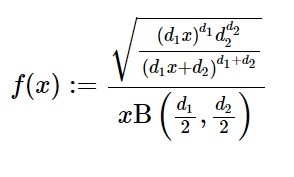借助sympy.stats.FDistribution()方法,我们可以获得代表F分布的连续随机变量。

用法:sympy.stats.FDistribution(name, d1, d2)
Where, d1 and d2 denotes the degree of freedom.
返回:Return continuous random variable.
范例1:
在这个例子中,我们可以通过使用sympy.stats.FDistribution()方法,我们可以使用该方法获得代表F分布的连续随机变量。
# Import sympy and FDistribution
from sympy.stats import FDistribution, density
from sympy import Symbol
d1 = Symbol("d1", integer = True, positive = True)
d2 = Symbol("d2", integer = True, positive = True)
z = Symbol("z")
# Using sympy.stats.FDistribution() method
X = FDistribution("x", d1, d2)
gfg = density(X)(z)
pprint(gfg)输出:
d2
— ______________________________
2 / d1 -d1 - d2
d2 *\/ (d1*z) *(d1*z + d2)
————————————-
/d1 d2\
z*B|-, -|
\2 2 /
范例2:
# Import sympy and FDistribution
from sympy.stats import FDistribution, density
from sympy import Symbol
d1 = 5
d2 = 6
z = 1
# Using sympy.stats.FDistribution() method
X = FDistribution("x", d1, d2)
gfg = density(X)(z)
pprint(gfg)输出:
____
5400*\/ 55
—————-
1771561*B(5/2, 3)
相关用法
注:本文由纯净天空筛选整理自Jitender_1998大神的英文原创作品 sympy.stats.FDistribution() in python。非经特殊声明,原始代码版权归原作者所有,本译文未经允许或授权,请勿转载或复制。
